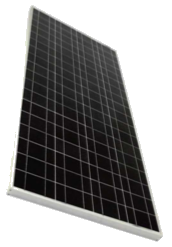Table of Contents
Monocrystalline Solar Panels and Polycrystalline
Monocrystalline

Overview and Appearance
This is the oldest and most developed of the three technologies. Monocrystalline solar panels as the name suggests are created from a single continuous crystal structure. A monocrystalline panel can be identified from the solar cells which all appear as a single flat colour.
Construction they are made through the Czochralski method where a silicon crystal ‘seed’ is placed in a vat of molten silicon. The seed is then slowly drawn up with the molten silicon forming a solid crystal structure around the seed known as an ingot. The ingot of solid crystal silicon that is formed is then finely sliced into what is known as a silicon wafer. This is then made into a cell. The Czochralski process results in large cylindrical ingots. Four sides are cut out of the ingots to make silicon wafers. A significant amount of the original silicon ends up as waste.
Polycrystalline
Overview and Appearance
Polycrystalline or Multicrystalline is a newer technology in which the manufacturing process varies.
Construction
Polycrystalline also start as a silicon crystal ‘seed’ placed in a vat of molten silicon. However, rather than draw the silicon crystal seed up as with Monocrystalline the vat of silicon is simply allowed to cool. This is what forms the distinctive edges and grains in the solar cell. Polycrystalline cells were previously thought to be inferior to Monocrystalline because they were slightly less efficient. However, because of the cheaper method by which they can be produced coupled with only slightly lower efficiencies they have become the dominant technology on the residential solar panels market.
In November 2015 Solar Panel Manufacturers announced that they had produced a multi-crystalline cell with an efficiency of 21.25%. This allowed them to produce polycrystalline modules with efficiencies between 18-20% a concept that was thought impossible as recently as 2013. Underpinning the new record for p-type multi-crystalline solar cells has been the continued quality improvements of multi-crystalline wafers that have helped push standard 60-cell Multicrystalline panels from 240W to 260W in recent years.
Polycrystalline are now very close to Monocrystalline cells in terms of efficiency.
Space Efficiency
Monocrystalline is generally more space efficient than polycrystalline. One square meter of Monocrysatlline solar cells will generate around 190W. One square meter of Polycrysatlline solar cells will generate around 180W.
Temperature Tolerance Polycrystalline solar cells generally have a lower temperature coefficient than monocrystalline solar cells. Lets say you have a 1kW of monocrystalline solar array on the same roof and side by side with a 1kW of polycrystalline array.
The monocrystalline array will be slightly smaller compared to the polycrystalline array as it is more space efficient.
However, the 1kW polycrystalline array will generally generate more electricity over the year when compared to the 1kW monocrystalline solar array because of its better temperature tolerance.
Cost
A Monocrytalline solar panel usually costs more than a polycrystalline solar panel, because there is more wastage in production of mono than in poly cells.
Aesthetics
A Monocrysalline solar panel generally makes a nicer looking solar panel as It is black in colour where polycrystalline is dark blue in colour.
However, the colour of polycrystalline cells has darkened significantly over the past few years and it is now looking a lot darker than it used to.
Low Light Conditions
A Monocrytalline solar panel usually performs marginally better than poly solar panels.
Effect of Shading
A monocrysalline solarxx panel is sensitive to shading.
Considering the following Major Criteria as follows:
➢ little difference in the efficiency between Mono and Poly Panels
➢ Greater yield of electricity over a year,
➢ Lower impact of deration on increase of temperature
➢ No major space constraints for home segments
➢ Lesser impact of shade
➢ Lower Cost /Watt
We suggest Polycrystalline Panels for majority of the end users in Nigeria.
However, for special projects, and cases which require Monocrystalline Panels, after having the overall Life-cycle Cost and knowing the space constraints etc, the mono panels can also be provided which is very well within the Mercury Manufacturing Range.


Please where can i locate mercury shop to buy genuine machine and batteries in edo state?
Hi Stanley,
Please give us a call on 07037451701
Hi Sir
How to get a cotation for your shop
I need battery 230 Ah-12 V ( 55pieces)
Best regards
Where is your service center in Lagos
call us on 07037451701
How much is solar panels 150 and 200watts
Hello sir, Mercury 150 watts mono solar panel is #39,000 and 200 watts mono solar panel is #50,000
I need all ur price list
visit http://www.mercurydirect.comn.mg to get the full price list.